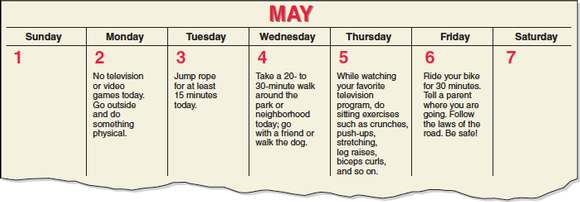Many states have established physical education standards that include specific outcomes in the cognitive, psychomotor, and affective domains. To achieve these standards, teachers include homework that moves physical activity and development of health-related fitness outside the gymnasium and into the home and community. This homework prompts students to explore and personalize a topic; enables a cross-curricular approach; incorporates a variety of strategies; and can increase communication between parents, students, and the school. Keep in mind the following considerations:
- Homework assignments should be purposeful and should extend opportunities for learning or practice.
- Homework can provide an additional opportunity for lesson content to be individualized and personalized for each student.
- Incorporate actual physical activity as a homework assignment or a portion of the assignment. If students design a health and physical activity calendar, ensure that they include activity as part of it (see figure 10.2).
- Ensure that homework assignments are connected to current lessons so that students can apply what they have learned in the classroom to the real world. Students live in the here and now, and keeping homework connected to current lessons keeps their experiences relevant.
- Homework can increase family involvement. Opportunities to link families and schools together can benefit all involved by increasing physical activity participation, opening avenues for communication, and developing stronger family relationships.
The possibilities for effective homework assignments cover a wide range. Assignments can be as simple as completing a worksheet or as comprehensive as developing a portfolio; the key is to incorporate as much movement and physical activity as possible. This type of homework can be done by all students, from kindergartners through high school seniors, as long as it is designed appropriately. Much of the information described in the preceding section (as topics for the classroom setting) can be modified for use in homework assignments, thus leaving more class time available for physical activity.
Sample Homework Assignments
These are examples of either a reflection or closure activity or a simple homework assignment for your students to complete.
Sports Reporting
Students attend a sporting event at their school. As they watch the event, they attend to the health- and skill-related fitness components that the athletes need in order to perform the activity effectively. After the event, students identify the components they observed during the game and cite examples.
Interview
Students interview a family member about personal physical activity habits and write a summary of the interview. Students can be asked to engage in the physical activities with their family member and describe this experience as part of the summary.
Brain Power
Students design crossword puzzles or word-finds for their peers using health-related fitness terms. As a follow-up, during a lesson, students can engage in activities that relate to these terms.
Question for the Day
Craft a question that prompts students to reflect on the day’s lesson. For example, when teaching a unit on golf, you might ask, “Which of the health-related fitness components can you maintain or improve through regular participation in golf?”
Event Participation
Students can prepare for and participate in a local activity, such as a community golf fundraiser. Students should describe their current level of skill and participation in the activity (in this case, golf). Then they detail how they are preparing for the event, describe the steps involved in taking part (e.g., registration), and record their practice activity. Finally, they can journal about their experience.
Research Paper
Students pick a successful athlete and find information about the workout regimen used by the athlete to stay sharp both physically and emotionally. Perhaps some local athletes would be willing to come to class and lead students through an appropriate workout. Even older student-athletes (carefully chosen) might serve as the “celebrity athlete” for a lesson.
Technology Connection
Students design a web page, create a video, or create a blog with peers to highlight one of the components of health-related fitness.
Active Andy and Suzy Slug
As an example, an assignment for primary students might begin by having a discussion about what it means to be active and what activities they can do at home or after school to stay active. Reproduce pictures of children being either active or not active and send them home with the students. Ask them to draw a happy face beside the pictures that show kids being active and a sad face beside those being inactive, then try one of the activity pictures with family members.
Health Calendar
Ask students to design a calendar that celebrates physical education, health-related fitness, and being healthy. The calendar can cover a week, two weeks, or a month (teacher’s choice). Students should plan activities to do during that time and log their success. Figure 10.2 presents such a calendar that was designed to celebrate National Physical Education Week, which is always the first week of May.

Figure 10.2 Keeping a calendar is a motivating way to help students track and plan the frequency of their participation in physical activity.